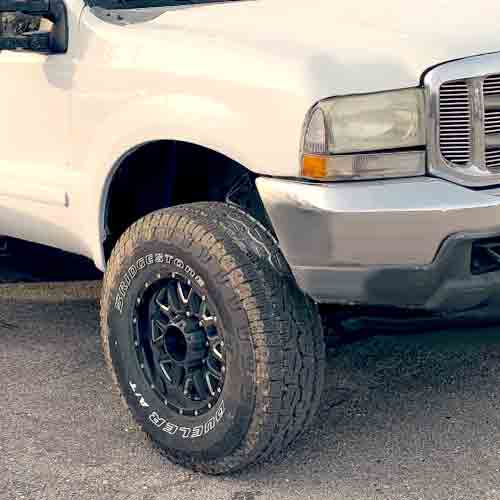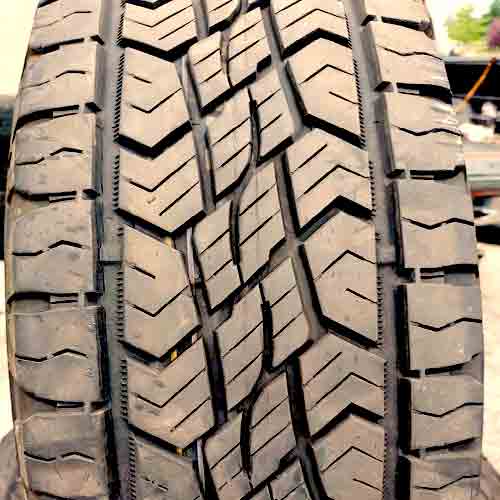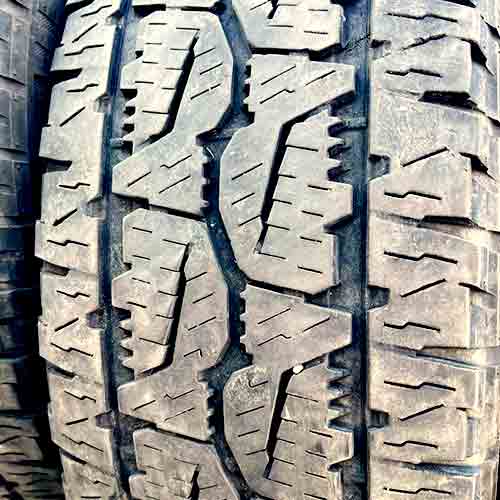Bridgestone Dueler AT Revo 3 and the Continental TerrainContact A/T are both designed with the all-terrain enthusiasts in mind. These tires are packed with innovative tread compounds and are designed to deliver exceptional performance, whether you’re off the beaten path or navigating the daily commute.

Being a tire engineer, form my perspective, the Continental TerrainContact A/T is one of the fastest and quietest tires you can get in A/T category. The tire also outperforms its counter part in wet traction as well. The Dueler A/T Revo 3 on the other hand, does better with fuel and offers superior tread life. Moreover its sand traction is worth noting as well. Other than this, both tires have similar efficacy on snowy and rocky tracks.
Sizes Available
The Bridgestone Dueler A/T Revo 3 comes with following specs.
- Rim sizes: 16 to 20 inches.
- Speed ratings: S, R, and T.
- Load ratings: SL, C and E.
- Weight range: 30 to 60 lbs.
- Tread depth range: 12 to 16/32″.
- Warranty: 60k miles (non LT sizes).
- Not rated with 3 peak mountain snowflake.
The Continental TerrainContact AT, on the other side, comes with similar rim sizes have following specifications.
- Speed rating: S, T, H, and one size even has V.
- Load ratings: SL to E.
- Weight range: 28 to 66.5 lbs.
- Tread depth range: LT sizes have 16/32″, and P metric have 12/32″.
- Winter ratings: only M+S.
- Miles warranty: 60k.
Design And Structure
Starting with the Continental TerrainContact A/T, the tire has a very on-road oriented design with five ribs in a closed up structure.

It’s middle most rib has lugs with more width, compared to those around, and they carry slanted rectilinear siping, and curved in-groove notches.
Moreover, all these blocks are attached to each other longitudinally (from underneath). This provides on-road stability.
The lugs on the surrounding ribs run in pairs, and they carry similar siping. Though towards their outer edges, in the wider circumferential they make, there are sharp saw tooth biters, (which are also called snow vices).
Moving towards shoulders, lugs are the biggest here.
They form a very squared off structure with wave-like siping on them. And their outer margins are not staggered.
On the other side, the Bridgestone Dueler Revo 3 is another less aggressive A/T tire.

The tread structure has 2 fat ribs in the middle containing a single block design, repeating itself longitudinally.
These lugs have sharp in-groove notches, rectilinear sipes, off-set edges and saw-tooth biters facing the shoulders.
And together, they form 3 circumferential grooves in the middle.
Furthermore, the shoulder lugs are sitting on a continuous running rib, (which is mostly seen with wear, as the image shows).
They are equipped with notches, thicker siping, and their outer margins are serrated.
Moreover, the tire also makes proper sidewall lugs, unlike the TerrainContact A/T.
Winter Traction
Although both tires aren’t 3 peak mountain snowflake (3PMSF) rated, they are both still pretty great.
The 3PMSF ratings isn’t everything. It only tells you that the tires with those symbols (on sidewalls) have 10% better acceleration capabilities, (on snowy roads) compared to average all season tires. It’s not related to handling and braking efficacy, as most folks think.
And so although both of these tires lack, when you compare them to dedicated winter tires, they are still above-average in mild snowy conditions.
Their outer circumferential grooves have “snow vices” in them, and their tread blocks are embedded with in-groove notches and numerous siping. All of these features help in grabbing the snow particles, lodging them in, and making contact with it.
Note: Snow to snow contact generated better results compared to snow to rubber.
Tread Noise
The noise on roads/tar, gets generated by a lot of variables, including rolling friction, surface textures creating different tones/frequencies of sound waves, and then there’s in-groove resonance. The list goes on.
And considering all of them, the Continental A/T not only outperforms Dueler A/T but nearly all of the other A/T tires in the list.
In other words, it’s the quietest A/T tire, that’s why it got ranked in my list of top all-terrains.
Dry Traction
When it comes to off road tires, they are not as capable of offering highway traction as seen on, say all season, or touring tires. Though as there’s a huge selection range of these tires, which also include some of the most on-road oriented ones as well, they are not so bad after all.
And that’s where these both tires are at. They offer superb directional and sideways grip, along with fast enough steering response, the 3 main factors I discussed below in details.
Directional Grip
This grip is basically considered on highways, as it has to do with rolling straight. And with both tires featuring decent footprint availability to meet up with the ground, they get to provide plenty of it.
Though the Continental TerrainContact A/T still remains unbeatable here, as it shows up with shorter braking distances (direct measure of directional grip).
Basically when rolling straight, the central portion of the tread gets to bear most of the weight on itself, and this tire with running rib there, offers superior stability, whereas on Dueler A/T, the central most area consist of (curvy) longitudinal channel instead.
Dry Handling
Handling also depends on footprint a tire offers, but form the shoulders, as the weight of the tire shift towards edges, when it corners.
But with both tires offering plenty of it, with their extremely packed up lugs there, its only explained by the tread compound, why TerrainContact offers better results in this department, as well.
It basically supplies a better combination of stiffness and flexibility to its lugs, and this renders superior steering sensitivity.
As the tire turns, it’s lugs want to bend. If the tread is too flexible, the tire would show up with under-steering, while the other accounts for over-steering.
The Bridgestone Dueler A/T does not offer a good enough balance in both, especially when compared to its counterpart. That’s why it’s only rated with up to T in speed rating, while the Continental A/T shows up to V.
It’s the fastest A/T tire. (I covered more on it here).
Wet Traction
Wet tarmacs are tricky, as water is not compressible, and has to leave out of the tread, in order for the tire to grip.
Wet Grip
Wet grip is dependent on the tread’s flexibility and siping it carries, so with higher silica density (which produces softer rubber), and ample sipes, a tire yields more desirable results.
And those are seen better on the Continental TerrainContact A/T. The tire offers greater number of sipes with 2 different types of patterns (interlocking on shoulder blocks, and rectilinear on the central blocks). And they account for better wiping abilities.
Moreover with multiple angles to these sipes, they don’t tend to get stiffer as the tire corners, or brakes for example (relatively speaking).
The Bridgestone Dueler A/T Revo 3 in comparison, does not offer as much of an effective siping structure, though the tire offers similar resistance to hydroplaning.
Hydroplaning
Hydro or aquaplaning takes place when the tire can’t clear off water from its tread effectively, resulting in floating.
Though this is not an issue on voided tires, such as these we are discussing, which offer multiple aqua-channels for the water to escape out.
Off Road Traction
I analyzed both these tires in all of the following off-road tracks. And so let me share how they performed next to each other.
Sandy Dunes
On sand you need a tire having a softer tread, and lighter weight, as both these features affect it’s floating abilities.
That’s why with a heavier structure, and missing sidewall lugs, the Continental TerrainContact can’t offer similar grip, compared to its counterpart.
The Dueler Revo 3 features sidewall lugs, which although aren’t that thick, it’s pasted on a larger surface area.
So by lowering the air pressure (which you almost always do on sand), its lugs spread out enhancing overall contact patch of the tire, and with it floating abilities.
On Mud
Running such less aggressive all-terrain tires, like these, can be a nightmare on muddy tracks, especially deeper ones.
As here, you need a lot of voids to properly clean of the tread with thick sticky clay.
And both of these tires with packed up outer shoulder lugs, and continuous, longitudinally (aligned) inner ribs, restricts the mud’s sideways flow.
Though still out of them, things do seem slightly better on Continental, as the tire features a better interlocking middle section, with smaller blocks (which help in cutting down the mud particles, to avoid packing).
Rocky Tracks
Climbing rocks demands durability, which gives you the confidence needed to move on this sharp terrain. And besides that, of course, you also need grip from multiple sides.
And considering both, I have to say, these tires are equally capable.
The TerrainContact A/T comes with better middle section, delivering grip both longitudinally and laterally, thanks to it’s multiple-angled in-groove notches.
Whereas the Dueler A/T Revo 3 supplies better sidewalls, and sharp shoulder biters supplying almost equal traction with lowered air pressure.
Side Note: Durability depends on internal construction, and outer skin. And both tires come up with cut resistant rubber on top, with almost similar tread depth range, and on the inside, they feature 2 ply polyester casing, with 2 steel belts, covered by a single nylon cap ply.
Fuel And Tread Economy
A tire with higher rolling resistance would consume more fuel and burn faster. And it depends on tire’s weight and it’s ability to let go the surface (stickiness).
Considering these factors it makes sense why out of both tires, the Continental Terrain Contact A/T lacks, with heavier weight (on average) putting more force on it’s lugs, as they rub off the surface.
Whereas as on Dueler A/T lugs don’t bear as much weight pressure, and show up with low rolling resistance values.
Verdict?
Both tires are very different in their designs, and it also goes for their performance as well.
Out of both, the Continental TerrainContact AT supplies superior directional grip and handling along with steering response in both wet and dry environments, and its one of the quietest tires you can get in the all-terrain category.
The Bridgestone Dueler AT Revo 3 on the other hand, supplies better fuel economy and tread life, gives slightly better winter traction, and has similar rocky terrain performance. Though it’s better on sand in an incline traction test.